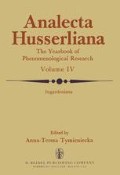Abstract
In striking contrast to the influential streams of his time, Roman Ingarden’s philosophy of language and logic is clearly anti-positivistic in its nature. While the syntactic ideology of the Vienna Circle was achieving its high peak and the successful mathematical logic of Russell, Hilbert, Gödel and Tarski did not even admit a dissenting voice in the traditional field of philosophical logic, Ingarden published his masterpiece, The Literary Work of Art,1 which contains a full-blooded theory of language, and he also launched an attack against a positivistic interpretation or misrepresentation of logic and its rôle in philosophy.2 Moreover, his criticisms of the contemporary mathematical logic were supplemented by his pioneering work in the theory (and logic) of questions,3 and by his treatments of hypothetical propositions,4 among other of his positive contributions. It is true — and the inspection of his bibliography reveals it — that Ingarden was not primarily a logician, not even a philosopher of language. His concerns with logic and language are part of a greater plan: the phenomenological reconstruction of philosophy via ontological structural analysis — in particular the analysis of works of art. Such a tremendous task asks for an analogue of Aristotle’s Organon. Ingarden inherited portions of a phenomenological Organon from his teacher, Husserl, and other leading members of the phenomenological movement, especially A. Pfänder.5
Access this chapter
Tax calculation will be finalised at checkout
Purchases are for personal use only
Preview
Unable to display preview. Download preview PDF.
Notes
Das literarische Kunstwerk, 3rd ed., M. Niemeyer, Tübingen, 1965; first published in 1931. Polish translation, O dziele literackim (PWN, Warszawa, 1960). The English translation by G. G. Grabowicz (Northwestern University Press, Evanston, Ill., 1973), from the 3rd German edition. Hereafter quoted as Literary Work.
See the polemic article Der logistische Versuch einer Neugestaltung der Philosophie’, Akte des VIII Internationalen Kongress fur Philosophie in Prag,Prague, 1934; as well as ‘Krytyczne uwagi o logice pozytywistycznej’, Z teorii jezyka i fzlozoficznych podstaw logiki, PWN, Warszawa, 1972, pp. 191–221.
’Essentiale Fragen’, Jahrbuch far Philosophie and phänomenologische Forschung VII Halle, 1925), pp. 125–304. Polish translation, ‘O pytaniach esencjalmych’, Z teorii jezyka…, pp. 327–482.
Part of this appeared in English translation as ‘The Hypothetical Proposition’ (tr. By F. Kaufmann), Philosophy and Phenomenological Research,XVII, no. 4 (1958), pp. 435–450. The full text is in Polish, in Z teorii jezyka…,pp. 260–325.
A. Pfänder is one of the most quoted authors in Literary Work. His Logik,3rd ed., M. Niemeyer, Tübingen, 1963 (first published in Jahrbuch fir Philosophie IV (1921)) seemed to have provided Ingarden with very efficient tools. See also my article `The ‘A priori’ in Ingarden’s Theory of Meaning’, Analecta Husserliana III (1974) 138–146.
This work of Husserl (recently translated in English by D. Cairns; M. Nijhoff, The Hague, 1969) was published in 1929, while Das literarische Kunstwerk had been close to its printing stage.
Some of them have been included in vol. IX of his Philosophical Works, entitled Z teorii jezyka i ftlozoficznych podstaw logiki, PWN, Warszawa, 1972.
See G. Kling, Ingarden on Language and Ontology’, Analecta Husserliana II (1972) 205f.
See A. T. Tymieniecka, ‘The Second Phenomenology’, For Roman Ingarden Nine Essays in Phenomenology ed. A.-T. Tymieniecka (M. Nijhoff, The Hague, 1959), pp. 1–5; the essays of F. Kersten and D. Laskey in Analecta Husserliana II (1972); and Ingarden’s own works on this theme.
For the explanation of this notion, as well as the concepts of other theories of meaning • ideational, behavioristic, ‘use-instead-of-meaning’ (late-Wittgensteinian or Austinian), see the standard textbook, W. Alston, Philosophy of Language, Prentice Hall, Englewood Cliffs, N.J., 1964.
Literary Work,par. 10, p. 43. The explicit reference to Frege can be found only in a footnote in the Polish edition (1960).
Let us mention the classical antinomy of the name-relation, the history and reconstruction of which is given in R. Carnap, Meaning and Necessity,2nd enl. ed., The University of Chicago Press, 1956, 3rd chap.
Literary Work,par. 18, especially pp. 96–97; a critique of the Logical Investigations period of Husserl.
C. I. Lewis’ theory of meaning, as exposed in his ‘The Modes of Meaning’, in L. Linsky (ed.), Semantics and the Philosophy of Language,University of Illinois Press, Urbana, Ill., 1952, pp. 50–63, comes to mind. Lewis’ prodigal use of four aspects of meaning was criticized by A. Church in Journal of Symbolic Logic 9 (1944) 28–29. A similar criticism could be applied against Ingarden’s theory.
He admits briefly that the word ‘truth’ could mean, among other things, ‘the purely intentional correlate of a true judicative proposition’ (Literary Work, par. 52, p. 301), but not in a literary work of art. Various concepts of truth were analyzed by him in `Des différentes conceptions de la vérité dans l’art’, Revue d’esthétique, II no. 2 (Paris, 1950), pp. 162–180. See also his Polish articles in Studia z estetyki I ( PWN, Warszawa, 1966 ), pp. 395–464.
’Bemerkungen über das Wesen, die Wesenheiten and die Idee’, Jahrbuch fib. Philosophie and phänomenologische Forschung IV (Halle, 1921) 496–543.
Author information
Authors and Affiliations
Editor information
Rights and permissions
Copyright information
© 1976 D. Reidel Publishing Company, Dordrecht-Holland
About this chapter
Cite this chapter
Riska, A. (1976). Language and Logic in the Work of Roman Ingarden. In: Tymieniecka, AT. (eds) Ingardeniana. Analecta Husserliana, vol 4. Springer, Dordrecht. https://doi.org/10.1007/978-94-010-1443-4_8
Download citation
DOI: https://doi.org/10.1007/978-94-010-1443-4_8
Publisher Name: Springer, Dordrecht
Print ISBN: 978-94-010-1445-8
Online ISBN: 978-94-010-1443-4
eBook Packages: Springer Book Archive

